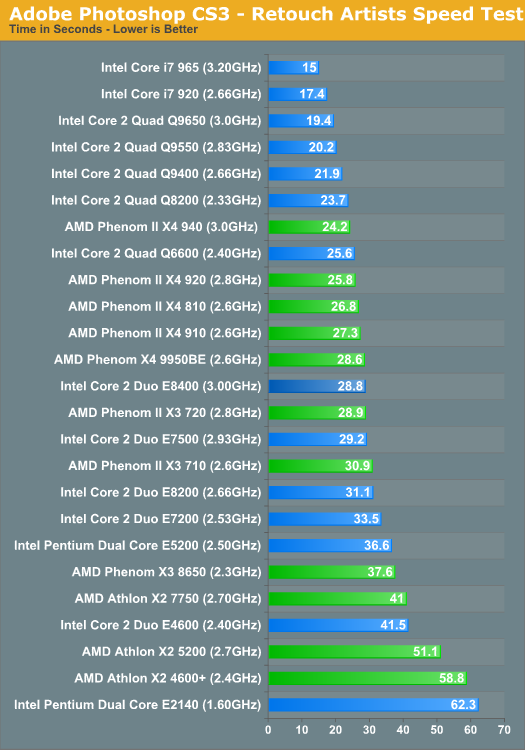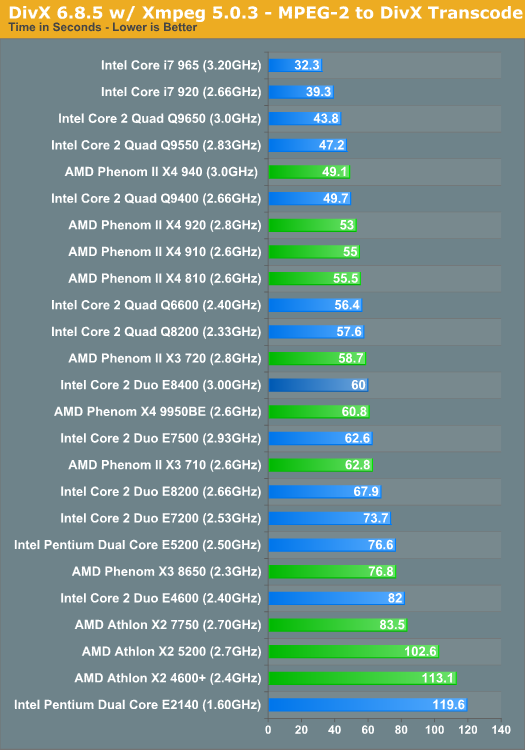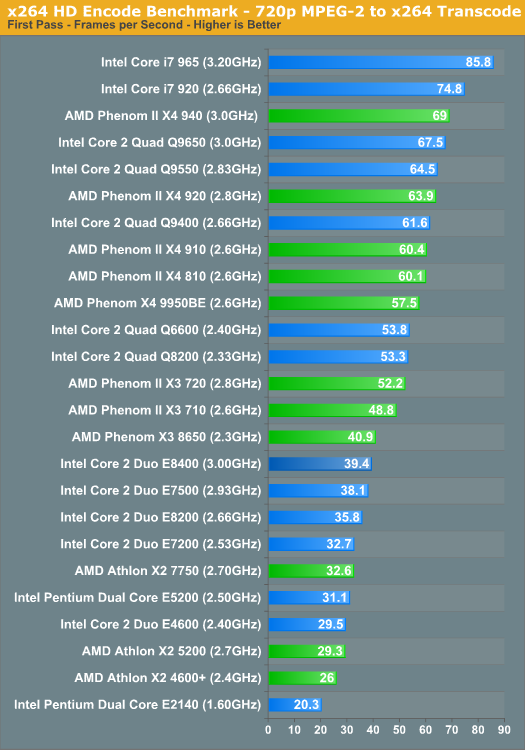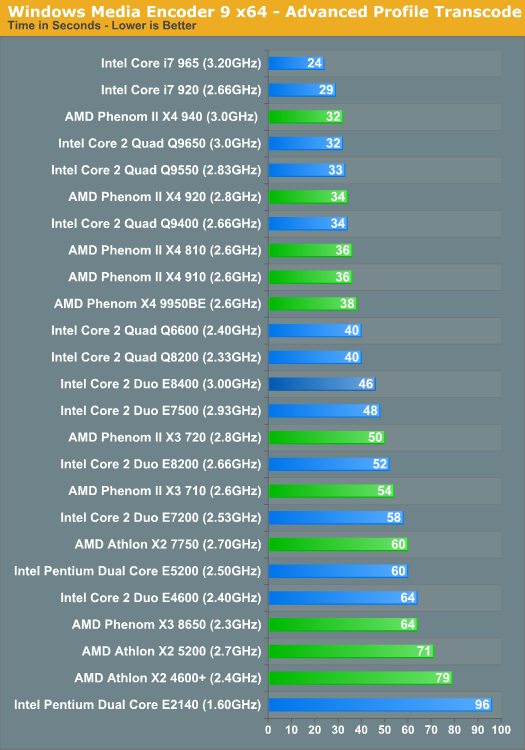The Phenom II X4 810 & X3 720: AMD Gets DDR3 But Doesn't Need It
by Anand Lal Shimpi on February 9, 2009 12:00 AM EST- Posted in
- CPUs
Adobe Photoshop CS4 Performance
To measure performance under Photoshop CS4 we turn to the Retouch Artists’ Speed Test. The test does basic photo editing; there are a couple of color space conversions, many layer creations, color curve adjustment, image and canvas size adjustment, unsharp mask, and finally a gaussian blur performed on the entire image.
The whole process is timed and thanks to the use of Intel's X25-M SSD as our test bed hard drive, performance is far more predictable than back when we used to test on mechanical disks.
Time is reported in seconds and the lower numbers mean better performance. The test is multithreaded and can hit all four cores in a quad-core machine.

While our Photoshop CS4 benchmark clearly prefers Intel's CPUs, the results aren't so clean cut. The entire Phenom II 800 and 900 lineup falls short of their competitors, but the Phenom II X3 720 can equal its rival: the Core 2 Duo E7500. It's slower than the more expensive E8400, but it's at least competitive.
This is where AMD has some potential to do well. As a result of its larger die, the 720 has one more core than Intel's svelte Core 2 Duos. In well threaded applications, the X3 could come out ahead.
DivX 8.5.3 with Xmpeg 5.0.3
Our DivX test is the same DivX / XMpeg 5.03 test we've run for the past few years now, the 1080p source file is encoded using the unconstrained DivX profile, quality/performance is set balanced at 5 and enhanced multithreading is enabled:

Both the Phenom II 900 and 800 series parts are competitive here. The Phenom II X3 720 actually beats out both competitors here, the E7500 and E8400 are close but no faster than the 720. Here's a benefit of that extra core at work.
x264 HD Video Encoding Performance
Graysky's x264 HD test uses the publicly available x264 codec (open source alternative to H.264) to encode a 4Mbps 720p MPEG-2 source. The focus here is on quality rather than speed, thus the benchmark uses a 2-pass encode and reports the average frame rate in each pass.

The first pass of the x264 benchmark is actually an analysis pass, the real encoding is done in the second pass. There are apparently quite a few unaligned cache accesses in this test which severely penalize the Core 2 processors; Core i7 is unaffected. Because of the unaligned cache access performance penalty, AMD owns the price/performance comparison here.

The actual encode workload is much more competitive. The Phenom II 800 and 900 series chips cluster around each other, remaining competitive but not really any faster than the equivalently priced Core 2 Quads. The Phenom II X3 720 continues to be faster than its competitor thanks to its core count advantage.
Windows Media Encoder 9 x64 Advanced Profile
In order to be codec agnostic we've got a Windows Media Encoder benchmark looking at the same sort of thing we've been doing in the DivX and x264 tests, but using WME instead.

Here we've got, once again, a competitive AMD but there's something very interesting going on with the triple core 720. WME9 doesn't make use of the third core as it is hard coded to use powers of 2 for the number of processor cores. There are some applications that will exhibit this sort of behavior, although in our testing the numbers are limited. With its third core out of the picture, the 720 is slower than Intel's Core 2 Duo E7500.










77 Comments
View All Comments
Denithor - Monday, February 9, 2009 - link
Such as power consumption/heat charts for the dual core chips.(I mean, come on, these chips still hang with the quads in many cases, I want to see how much better they are from a power consumption standpoint - is it worth the upgrade to quad if you've got a speedy dual?).
To me it looks like the AMD chips give a lot better scaling when increasing the core count (X3 720 -> X4 920) than the Intel chips (e8400 -> Q9650). In most of the multi-threaded apps the AMD processors saw >95% increase (of the theoretical 33.3% possible) versus Intel with about 70-80% (of the theoretical 100%) on average. I wonder if this has to do with the fact the AMD chips are monolithic in design (more efficient interface among cores).
waffle911 - Monday, February 9, 2009 - link
The image of the "socket AM3" is actually of the AM2... it still has 940 pin sockets, not 938.JimmiG - Monday, February 9, 2009 - link
You need to change the "compatibility matrix" to reflect that an AM3 CPU will "maybe" work with an AM2+ mobo. Second-rate manufacturers like Asus will not release the needed BIOS updates for some of their older boards like the 790FX/SB600-based Asus M3A32-MVP Deluxe. If you have a SB7xx-based board and it's not made by Asus or another second-rate mobo manufacturer, the matrix is probably accurate.fishbits - Monday, February 9, 2009 - link
"We really have to applaud both companies here. Intel for responding so quickly and effectively; the 40% price drop on the Q9650 just made sense and now you can have a chip with 12MB of L2 cache for under $300 thanks to the Q9550."You're applauding Intel over this? To me, looks like they were screwing over customers with a gigantic artificial price premium. If it weren't for stepped-up competition from AMD, the price would have remained in the stratosphere. Intel is entitled to price however it wants, but I'm not going to applaud them for lowering prices only because another company exposed their gargantuan profit margin.
Juat a tiny taste of what would be to come if only Intel were left standing. If fanbois who wish AMD harm ever got their wish, there'd be no competitive pressure on CPU prices, and we see what Intel does in that position. We really need two healthy CPU makers in business.
Finally - Tuesday, February 10, 2009 - link
You know something's fishy, when a supposed article about a new AMD CPU starts with one full page of how Intel is the greatest evar... (and how much dropped their prices, which shall suggest to your mind that they are more interesting while they in fact go from Gargantuan to "normal" pricing for their products...)Maroon - Monday, February 9, 2009 - link
^agree^Why in the hell would you "applaud" Intel for price gouging? I know it's partly AMD's fault by not having truly competitive cpus for the last 2 years, but I'm not gonna give Intel props because they had to reduce prices to remain competitive in those price segments.
poohbear - Monday, February 9, 2009 - link
AMD Phenom II X3 710 is gonna be priced at around 125-135 i imagine, maybe even less, and for that price im sorry its a clear pick for those on a budget!! Its got 7.5mb cache, 3 cores, and will overclock to 3.6ghz if the 720 is any indication. Such sweetness. Any eta on em yet?BLaber - Monday, February 9, 2009 - link
As far as I have read on some other sites AMD sent an email along with the test samples to reviewers to test the cpus on AM2+ mobo for time being bcz AM3 mobo bios are having some performance issues.Nightstalker - Monday, February 9, 2009 - link
I don't understand the conclusion that there is no benefit to DDR3, when these CPU's were tested with DDR2. How about including results on these CPU's with both types of memory so we can see how they perform?Gary Key - Monday, February 9, 2009 - link
We will have additional DDR3/DDR2 results this week, we had AM3 BIOS releases coming until Friday night, the last one actually worked although it broke AOD and TurboV compatibility on the ASUS boards. We still cannot get DDR3-1866/2000 working. Of course, DDR3-1333 is the highest official support offered but we figure if it is in the BIOS then it should work.